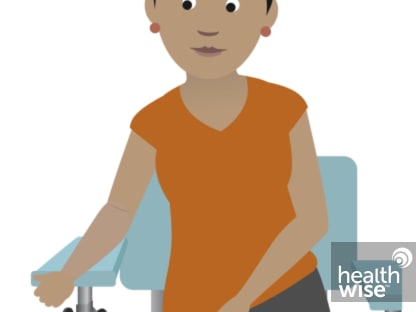Quad Screening Test
The quad screening is a blood test that may be done at 15 to 22 weeks of pregnancy. It's used to look for certain birth defects or genetic conditions in the fetus. The quad screening measures the amounts of four things in your blood. They are:
- Alpha-fetoprotein (AFP). AFP is made in the liver of a fetus.
- Human chorionic gonadotropin (hCG). This hormone is made by the placenta during pregnancy.
- Estriol (uE3). This is a form of estrogen that increases during pregnancy. It's made in large amounts by the placenta.
- Hormone inhibin A. This hormone is produced by the fetus and the placenta.
This test can't show for sure that a fetus has a problem. You would need a diagnostic test called amniocentesis to find out for sure if there is a problem.
Why It Is Done
The quad screening is done to find out the chance that the fetus has certain birth defects or genetic conditions, such as Down syndrome, spina bifida, or anencephaly.
How It Is Done
A health professional uses a needle to take a blood sample, usually from the arm.
Watch
Results
A "positive" result means that there is a higher-than-average chance the fetus has a birth defect or genetic condition. If the result is "negative," or normal, it means that the fetus probably doesn't have a birth defect or genetic condition. But it doesn't guarantee that you will have a normal pregnancy or a healthy baby.
The accuracy of a quad screening test is based on how often the test correctly finds a condition.
- It correctly finds neural tube defects, such as spina bifida, in up to 80 out of 100 fetuses who have it. It finds anencephaly in about 95 out of 100 fetuses. The test misses spina bifida in at least 20 out of 100 fetuses who have it. And the test misses anencephaly in about 5 out of 100 fetuses.
- It correctly finds Down syndrome in 81 out of 100 fetuses who have it. It misses Down syndrome in 19 out of 100 fetuses.
Your doctor or midwife may tell you the result of your test as a set of numbers. A certain number is often used as a cutoff for a positive result. For example, your doctor or midwife may say the cutoff is 1 out of 200. This means that if your result is 1 out of 200 or 1 out of a number less than 200 (such as 1 out of 100), you have a positive result and the fetus has a higher chance of a birth defect. If your result is 1 out of 300, this means that you have a negative result and the fetus has a lower chance of a birth defect.
With the quad test, there is a chance of getting a false-positive test result. This means that the test could show a problem when the fetus doesn't have the problem.
A false-positive result can cause stress and lead to tests you don't need (such as an amniocentesis). In many cases, those who get a positive screening test result are actually carrying a healthy baby.
Sometimes negative test results can be wrong too. They may show that the fetus is fine when there is a birth defect or genetic condition. (This is a false-negative test result.)
Your doctor or midwife will use your age and the age of the fetus to interpret the test results.
Related Information
Credits
Current as of: July 15, 2025
Author: Ignite Healthwise, LLC Staff
Clinical Review Board
All Ignite Healthwise, LLC education is reviewed by a team that includes physicians, nurses, advanced practitioners, registered dieticians, and other healthcare professionals.
Current as of: July 15, 2025
Author: Ignite Healthwise, LLC Staff
Clinical Review Board
All Ignite Healthwise, LLC education is reviewed by a team that includes physicians, nurses, advanced practitioners, registered dieticians, and other healthcare professionals.



